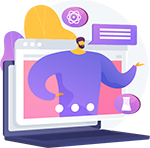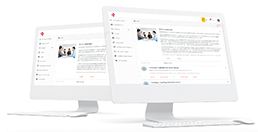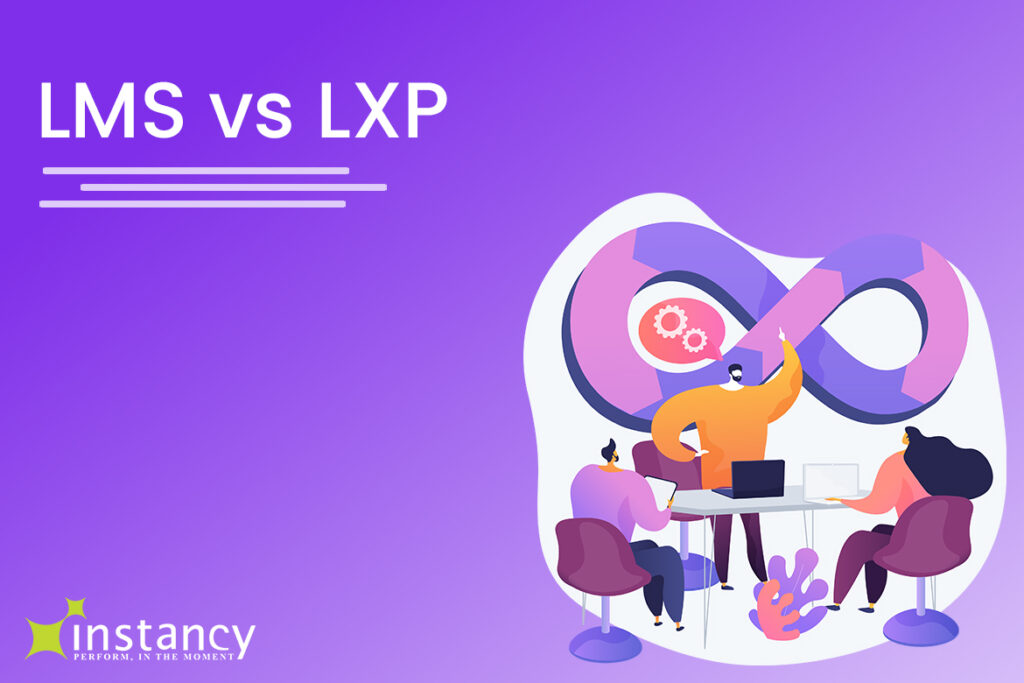Learning & Development is an industry that loves technology implementations. For learning platforms alone we’ve got LMS, LXP, IOL, LRS, SEP, etc.
For a lot of people, the difference between them is a little bit confusing, but it just doesn’t have to be. When it comes to the Learning Management System (LMS) and Learning Experience Platform (LXP), the difference is quite simple – it boils down to who manages the content and the learning journey.
"Online learning is not the next big thing, it is the now big thing.” - Donna J. Abernathy
So, let’s break down the key differences between LMS and LXP;
What is the Learning Management System (LMS)?
Learning Management System (LMS) is a software platform specially designed for training and development organizations. An LMS is an administrative tool that focuses on delivering, tracking, and reporting all educational content and events. The LMS is a more administrative-centric view.
‘Administration’ is the keyword for an LMS
The administrator controls the LMS. The administrator owns the content residing on the LMS and controls who gets to see what, also knowns as ‘permissions.’
Need to add a course to your curriculum? Give it to the administrator. Do you need to collect specific data for reports? The administrator compiles the information and presents it through the LMS Dashboard/Report feature.
Role of Learning Managers and Administrators
Learning Managers and Administrators can manage various processes and information ranging from users, instructors, courses and curriculum, classroom events, job roles, competency assignments, notifications, generate reports and data analytics about learning progress, and much more.
With the LMS, administrators can assign training content to learners. Learners get immediate notifications advising new course content is available and perhaps required. The LMS collects data such as the number of learners who have completed their assigned training, their assessment scores, and other parameters.
Bonus Tip to Remember
Note that the data collected by the LMS is significant, but it is the administrator or learning manager who decides specific data to include for various reports. Because the LMS has sophisticated database capability, this auditing ability is one of the most important benefits of a learning management system.
Evolution of Learning Management System (LMS)
Over time, the LMS has evolved through the advance of technology. It is a more intelligent platform with the ability to deliver many types of content media – videos, audios, PDF documents, and the list grows with each new software update.
The content best suited for an LMS is regulatory, compliance, or certification. These courses are required. The learner has little or no flexibility in what classes they take – the administrator or learning manager usually determines this.
An LMS carefully tracks and audits all data; hence, this data is vital for compliance and regulatory and required for certification.
In addition to regulatory and compliance, employees want to broaden their skills to remain current because of the rapidly changing business landscape. They may wish to take courses identified in their performance reviews. They may have subjects of interest to them; they feel it will make them more competitive.
Organizations are also finding their employees motivated to learn the information they feel is essential, not necessarily for their current job role. Companies increasingly use various learning tools to accomplish this on-demand learner requirement.
Features of the Learning Management System
“Learning experiences are like journeys. The journey starts where the learning is now and ends when the learner is successful. The end of the journey isn’t knowing more, it’s doing more.” — Julie Dirksen, Learning Strategy and Design Consultant
LMS features and functionality vary among products. However, some of the vital learning management systems include:
1. User Management:
The LMS offers the ability to manage all users, internal or external user groups, assignments, and track progress. Users include administrators and learners, instructors, and managers.
2. eLearning Course Delivery and Tracking:
Self-paced eLearning offers schedule flexibility. Learners can choose to take courses when it is convenient for them. The LMS manages the delivery and tracking in a digital format. eLearning standards such as SCORM and Cmi5 ensure courses designed with these standards in mind play on any learning management system.
3. Classroom Event Management:
Robust LMS systems manage both physical and virtual classrooms. The LMS tracks enrollment, instructor allocation, and where training materials reside.
4. Reports:
Administrators and learning managers can customize and schedule detailed information across all users, groups, courses, and classrooms.
5. Dashboards:
A dashboard is a visualization of specific data used to develop insights about learning outcomes, skill gaps, performance improvement, and other areas where there may be an impact on business.
What is A Learning Experience Platform?
A Learning Experience Platform (LXP) is relatively new to the learning community. Where the LMS revolves around the system and data, the LXP revolves around the learner. It provides modern user experiences.
The LXP is an intelligent platform. It learns about the student by analyzing their preferences and recommends learning specific learning paths. Where the LMS is data-centered, the LXP is user-centered.
The intelligent LXP platform provides access across multiple devices to support learners seamlessly. It takes data and consolidates it into a single portal while using various methods to engage learners. LXP’s most popular features include social learning, personalized learning, and individual learning paths.
Examples include video, podcasts, articles, blogs, microlearning, and user-generated content or links – learners want their user experience to be the same or similar to how they are receiving content in their personal lives. Social media is the new normal.
Users expect their day-to-day learning experience to mirror their social media preferences. Think of Netflix or Facebook. Think of group learning. Colleagues may add information they found outside the existing course materials. Because the LXP provides a venue for social collaboration, learners expect that in their learning system now.
Benefits of A Learning Experience Platform
- An open system that accommodates all internal and external resources
- Allows users to contribute their content to their colleagues
- Adaptive learning paths that tailor content experiences for individual users
- Encourages collaborative learning and mentoring
- Uses new eLearning standards such as API to track learning outside formal situations
Features of the Learning Experience Platform
The most popular requested features include:
1. Self Directed Learning
Learners want more control over their skills and professional development. They want the freedom to set their goals with the ability to pick and choose learning content. Learners prefer their learning to mirror their social media experiences.
Users want to access education or information when they want or need it. This is the central premise behind the LXP – self-directed and on-demand – a learner-centric learning platform with a modern user experience, consumer-grade user interface, and ease of use.
“If learners think it looks bad, you may have lost a good percentage of the battle in getting them to pay attention.” — Patti Shank, Director of Research, The eLearning Guild
2. Intelligent Experience
Because user preferences are so vast, the LXP must be smart enough to help them navigate their experience and create individualized learning paths. For example, if an employee wants to learn something they cannot find on their company platform, they want the freedom to search and procure globally. This essential learner requirement is the most compelling reason why organizations are scrambling to implement learning experience platforms. LXP pushes/recommends the information, alerts, and reminders to engage the learner. It has the intelligence to communicate with the learner using messaging and intelligent chatbots, notifying students when a topic of interest becomes available.
3. Seamless Access to Multiple Devices:
Learners want to access content anytime, anywhere, and on any device, including desktop, native mobile, and progressive web apps. Learners demand the flexibility to start a desktop course and later complete it at home on a mobile device.
4. Aggregates Content from External & External Sources:
Recently, users are increasingly requesting smaller, bite-sized courses. They find it challenging to sit down for more extended periods to complete the course.
With microlearning, the content is packaged so each mini-course has a definite beginning and ending, yet only takes a manageable time to complete. This is different from traditional eLearning courses where often a learner may pause the course mid-stream, impacting knowledge retention.
An additional positive outcome is that the learner can complete a smaller class and augment that content with third-party content providers. The Learning Experience Platform aggregates content from internal and external sources; it allows learners to go beyond the corporate training catalog.
5. Makes Recommendations Using AI:
“In every job that must be done, there is an element of fun. You find the fun and — SNAP! — the job’s a game!” — Mary Poppins, gamification pioneer
Remember that the LXP is an intelligent platform. Different LXP platforms have different intelligence levels, and some use artificial intelligence to recommend third-party blog posts, articles, PDFs, videos, and other documents to users searching for content tailored to meet their needs. The LXP fits perfectly with the blended learning model also.
Instructors can assign content with the blended learning model while, at the same time, learners feel empowered to delve deeper into topics of interest. Additionally, learners appreciate the ability to collaborate with subject matter experts, colleagues, and peers.
6. Social Learning:
In their daily lives, learners live in a social media world. Increasingly, they want continuity in their educational experience as well. Those students who want to contribute thoughts, ideas, and even share their knowledge (user-generated content) find they can do so if the learning experience platform supports social learning.
Because of the platform’s social’ nature, many platforms include rating systems similar to popular social media networks. Users can also leave public comments. Students can include links they found in their discovery to be useful to them.
Finally, those learners who feel proud of their expertise in the topic can showcase their knowledge to their peers. Because reputation scores are important, learners become known as authorities.
Must you Choose Between LMS and LXP
The short answer is NO. LMS and LXP are both beneficial to educational institutions and corporate training departments. When used together, these tools give organizations the flexibility to offer online training to external sales channels, franchisees, and even customers.
However, before starting a selection process for your software, every organization needs to review its primary objectives. Different vendors cater to unique consumer groups.
Some may specialize in eCommerce, some for marketing, with features and functionality peppered into the various product offerings. It is crucial to carefully research all the features and functionality of any platform you are considering.
“The only thing worse than training your employees and having them leave is not training them and having them stay.” — Henry Ford, Founder, Ford Motor Company
The Big Takeaway
Since 1990s learning management systems have been an essential part of organizations. With the coming of advanced learning platforms, the eLearning industry has been experiencing some significant changes.
Factors like the adoption of digital learning, the introduction of artificial intelligence, and machine learning in LMSs have boosted the demand for LMS.
Let’s check some interesting facts about LMS and LXP;
1. It is estimated that in 2021, the global LMS and eLearning markets will increase to around $15 billion and that by 2024, the global corporate LMS market size will grow at a compound annual growth rate of 23%.
2. Huge investments are globally being made in education technology. Recent market research has revealed that by the end of 2025, the worth of the LMS market will be around $28 billion.
3. On the LXP front, on an annual basis, the market share of LXPs have been growing twice their size. By 2020, the LXP market is expected to gain a value of around $200 million. This shows that LXPs are fast gaining popularity.
With more and more organizations now adopting it, LXPs are becoming an integral part of the learning environment.
4. Even when the learning experience platform was a fairly new concept, Josh Bersin, the founder of Bersin by Deloitte, had predicted its extensive growth. In 2018, the LXPs already had a market size of around $350 million, and have been doubling each year.
LMS and LXP Can Co-exist!
LMS and LXP functionality can co-exist. Stakeholders need complete flexibility. At times, they use more learner-centric functions and other times need admin-centric learning. Organizations that offer the flexibility of both platforms have a competitive edge.
Discerning users in the learning environment will appreciate the ability to perform what they want when they want, and however, they want. The learning experience = highly satisfied and motivated users – the hybrid LMS and LXP platforms.
So, it is not one or the other, but co-existence and ability to use more of this at one time and more of that another time.
The Instancy Learning Platform
While some people argue about the LMS’s importance versus the LXP, Instancy believes they are both critical. Instancy also believes all features and functionalities in both systems seamlessly interact with each other.
Instancy combines both software solutions best and offers the flexibility needed to use the LXP and the LMS. Most organizations need some of both. Instancy provides both!
The Instancy Learning Platform gives organizations a ‘no-code’ learning platform and design tools to configure the system per their business needs. It empowers all the stakeholders in the learning process, including the learners, managers, instructors, and administrators.
The Instancy Learning Experience extends across multiple familiar user interfaces on the internet – a desktop web browser, mobile responsive, progressive web app (PWA), mobile native apps, and chat applications like MS Teams. It combines features to automate many administrative tasks and provides comprehensive tools or apps to administrators to manage the necessary day-to-day activities.
Conclusion
Instancy believes the best approach is to combine the LMS and LXP for the best user experience. There is no need to choose one or the other. Those organizations that embrace both platforms will find their user experience ratings soar, leading to a plethora of positive outcomes. Instancy is passionate about this intelligent platform and continues to look for ways to merge technology for positive results.





